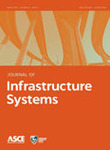Journal


Journal of Infrastructure Systems
Archives Papers: 176
The American Society of Civil Engineers
Please choose volume & issue:
-
Intelligent Multitasking Framework for Boundary-Preserving Semantic Segmentation, Width Estimation, and Propagation Modeling of Concrete Cracks
Abstracts:Abstract Crack detection is crucial for ensuring the durability, safety, and structural integrity of civil infrastructure. Traditionally, this task involves manual inspections and crack width measurements using a crack width comparator gauge. However, these methods are time-consuming, subject to subjective judgment, and prone to errors in spatial measurement. While automatic crack detection algorithms have been developed, most focus solely on a single issue using deep learning techniques. Comprehensive models that integrate crack segmentation, width estimation, and propagation assessment—essential for thorough structural evaluation—are still lacking. This paper presents the concrete health monitoring (CHM) system, a novel deep learning framework designed to enhance crack segmentation, width estimation, and propagation modeling in real-world scenarios. The CHM system employs a multimodal approach to concurrently perform these tasks. For crack segmentation, it introduces two innovations: multisource visual fusion (MVF) and attention-based hierarchical objective refinement (AHOR), addressing current methodological limitations. Width estimation is facilitated by a vision transformer regression model, and crack propagation is modeled using Paris’ law that correlates the crack growth rate with the stress intensity factor. Our results show that CHM achieves superior performance on a benchmark data set, with an accuracy of 87.26%, an intersection over union (IoU) score of 80.76%, and a recall rate of 84.51% for crack segmentation. For width estimation, it achieves a root mean squared error of 19.764. These outcomes affirm CHM’s efficacy in real-time infrastructure safety management.
Hot Journals
- Risk Breakdown Matrix for Risk-Based Inspection of Transportation Infrastructure Projects
- Social Control in Outsourced Architectural and Engineering Design Consulting Projects: Behavioral Consequences and Motivational Mechanism
- 2022 Best Paper Award
- Hold-Ups and Failures in Negotiated Order: Unearthing the Nuances of Rework Causation in Construction
- Prevalence and Risk Factors for Poor Mental Health and Suicidal Ideation in the Nigerian Construction Industry
- CFRP–Cable-Stayed Bridge Hybrid with Partial Suspension and a Span Exceeding 3,000 m: Concept, Optimization, and Construction
- Impact of Wind Load Characteristics on Computed Bridge Stay-Cable Forces Used for Bridge Health Monitoring
- Weak-End and Frequency Detection of Elastically Supported Bridges by Contact Residual Response of Two-Axle Test Vehicle in a Round Trip
- Development of Performance-Based Fragility Curves of Coastal Bridges Subjected to Extreme Wave-Induced Loads
- An Analytical Model to Evaluate Short- and Long-Term Performances of Post-Tensioned Concrete Box-Girder Bridges Rehabilitated by an Ultrahigh-Performance Concrete Overlay
- Three-Dimensional Velocity Distribution in Straight Smooth Channels Modeled by Modified Log-Law
- Experimental Investigation on Flow Past Two and Three Side-by-Side Inclined Cylinders
- An Experimental Investigation of Rotor–Box Aerodynamic Interaction 1
- Modeling Gas–Liquid Flow Between Rotating and Nonrotating Annular Disks
- Entry Length Requirements for Two- and Three-Dimensional Laminar Couette–Poiseuille Flows
Advanced Materials (3,745)
- Structured Perovskite Light Absorbers for Efficient and Stable Photovoltaics
- Strategies for High‐Performance Solid‐State Triplet–Triplet‐Annihilation‐Based Photon Upconversion
- Atomic Engineering Catalyzed MnO2 Electrolysis Kinetics for a Hybrid Aqueous Battery with High Power and Energy Density
- Crystal Adaptronics: Global Performance Indices for Dynamic Crystals as Organic Thermal Actuators (Adv. Mater. 20/2020)
- Enlightening Materials with Photoswitches
Acta Astronautica (1,768)
- Mixed-integer trajectory optimization with no-fly zone constraints for a hypersonic vehicle
- Adaptive control design for active Pogo suppression of large strap-on liquid launch vehicles
- Machine learning based approach for modeling and forecasting of GPS–TEC during diverse solar phase periods
- Effect of two-dimensional micro-cavity surface on hypersonic boundary layer
- Investigation on burning behaviors of aluminum agglomerates in solid rocket motor with detailed combustion model








 User Center
User Center My Training Class
My Training Class Feedback
Feedback




